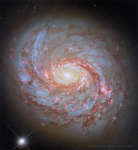Список публикаций
за 2025 год.
|
An example of violence on a cosmic scale, enormous elliptical galaxy NGC 1316 lies about 75 million light-years away toward Fornax, the southern constellation of the Furnace. Investigating the startling sight, astronomers suspect...
Как могло бы выглядеть погружение в чудовищную черную дыру? Эта картинка получена визуализацией с помощью суперкомпьютера. Она показывает все небо, как его видела бы воображаемая камера, летящая к черной дыре с массой в 4 миллиона солнечных. Такая черная дыра находится в центре нашей Галактики.
Что происходит в центре близкой спиральной галактики M77? Эта галактика видна плашмя, удалена от нас всего на 47 миллионов световых лет и расположена в созвездии Кита. Размер величественной островной вселенной, известной также как NGC 1068 – около 100 тысяч световых лет.
Насколько типичной является наша Солнечная система? Исследования пролетающей через нашу систему кометы 3I/ATLAS могут дать ответ. Ранее уже были зарегистрированы межзвездные пришельцы: астероид, комета, метеор и газовый ветер, в котором доминировали водород и гелий.
Что бы мы увидели, стоя на поверхности Титана? На цветной фотографии запечатлен незнакомый ландшафт на поверхности далекого Титана – самого большого спутника Сатурна. Снимок получен в 2005 году сразу после спуска на поверхность зондом Европейского Космического агентства "Гюйгенс". Спуск зонда продолжался 2.5 часа в плотной атмосфере, состоящей из азота с примесью метана.
Журнал "Небосвод" для любителей астрономии
Уважаемые любители астрономии! Календарь наблюдателя на февраль 2026 года + карты путей комет и астероидов
Это не сцена из видеоигры. Кажется, что маленькая церковь в горах спряталась от Луны за лесом. Снимок с помощью телеобъектива был сделан 23 ноября. Стены церкви освещены фонарями на поверхности Земли. Луна светится отраженным солнечным светом. В любое время Солнце освещает половину поверхности Луны – ее дневную сторону.
NGC 6888, известная также как туманность Полумесяц – космический пузырь диаметром около 25 световых лет, выдутый ветром от центральной яркой и массивной звезды. Для создания картинки использованы глубокие телескопические изображения, полученные с узкополосными фильтрами, позволившие выделить излучение атомов водорода и кислорода. Атомы кислорода создают сине-зеленое свечение, в которое погружены образующие сложные структуры волокна туманности.
Большая красивая спиральная галактика NGC 1055 доминирует в маленькой группе галактик, удаленной от нас на 60 миллионов световых лет и расположенной в созвездии Кита. Островная вселенная видна сбоку, ее размер – более 100 тысяч световых лет, что немного больше, чем у нашей Галактики Млечный Путь. |
|









